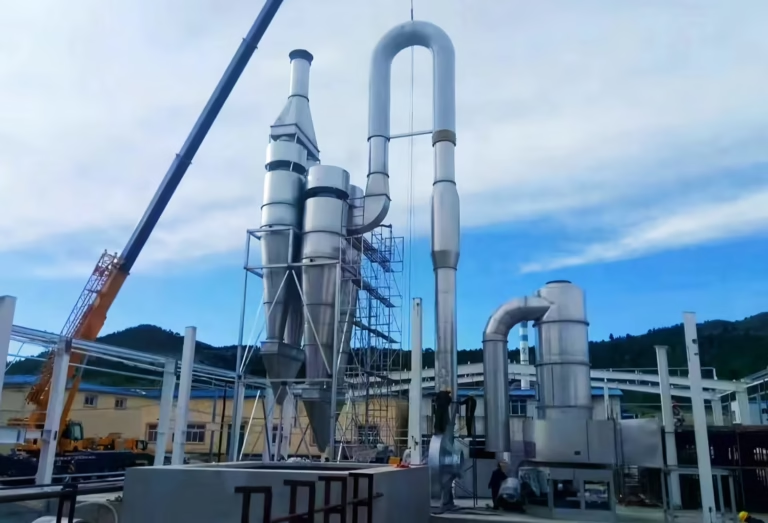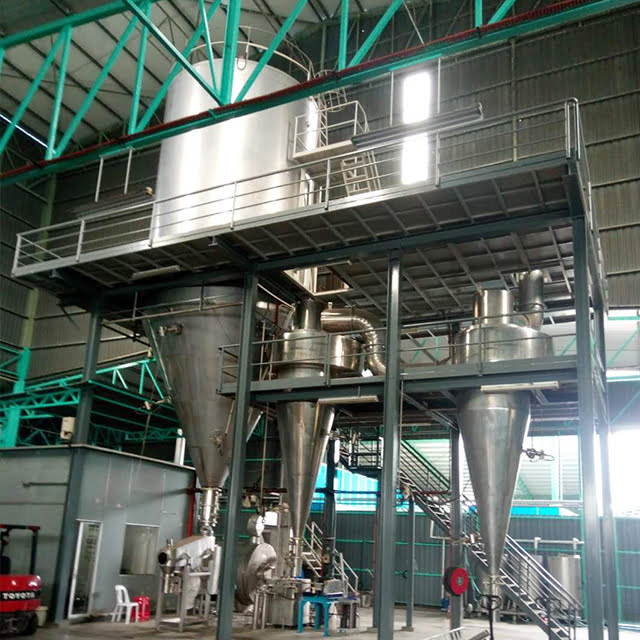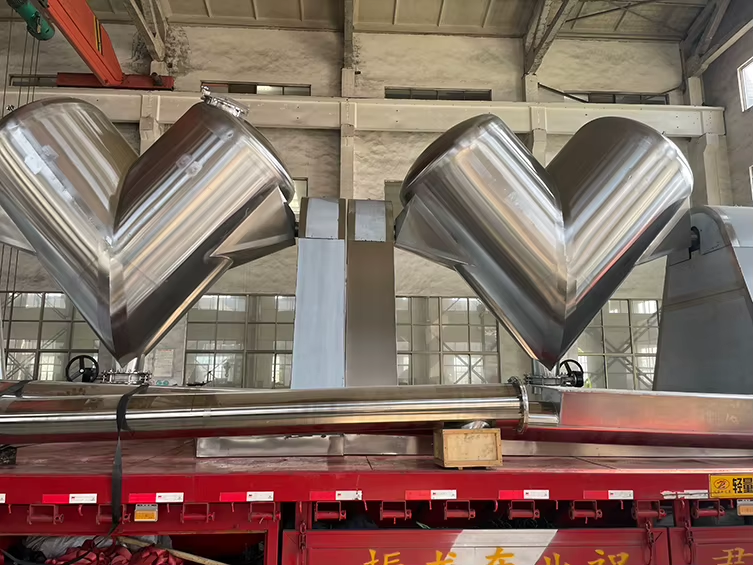喷嘴雾化器与喷雾干燥器中的旋转雾化器更好
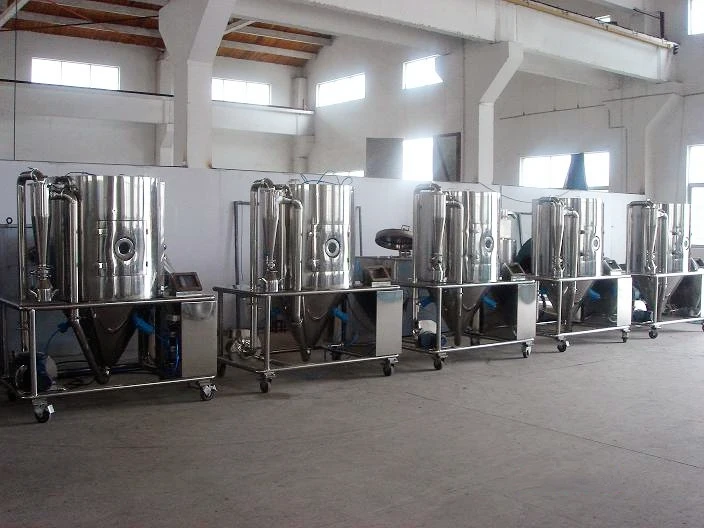
选择用于喷雾干燥的最佳喷雾干燥器雾化器取决于您的具体需求. 喷雾干燥机的操作方式有所不同 液滴尺寸, 能源消耗, 和维护要求. 最近的计算机研究表明 旋转式和喷嘴式喷雾干燥机雾化器产生不同的喷雾图案 和干燥结果. 这会影响粉末质量和整体工艺效率. 专家评估液滴尺寸, 能源使用, 以及雾化器处理各种饲料类型的能力. 使用正确的喷雾干燥机雾化器可确保每次获得一致的结果. 选择合适的雾化器会显着影响喷雾干燥过程和最终产品的质量.
关键要点
喷嘴原子剂 使液滴大小几乎相同. 它们节省能源并且需要更少的维修. 这使得它们非常适合小型或中型喷雾干燥作业.
旋转雾化器 适合处理厚的或块状的饲料. 您可以通过改变轮速来改变液滴尺寸. 但它们消耗更多的能量并且需要更多的修复.
根据您的饲料类型选择合适的雾化器. 它还取决于您想要生产多少以及您需要什么粉末质量. 这有助于节省能源并提供稳定的结果.
喷嘴雾化器使粉末更均匀. 这对于食品和药品很重要. 旋转雾化器更适合大型作业和困难的饲料.
经常清洁并使用正确的设置有助于雾化器正常工作. 这可以帮助您每次都获得最好的粉末.
快速比较
主要差异
您需要了解每种雾化方法的工作原理. 这可以帮助您选择最好的 喷雾干燥机雾化器. 下表显示了喷嘴和旋转雾化器在喷雾干燥中的不同之处:
因素 | 喷嘴雾化器 | 旋转雾化器 |
|---|---|---|
液滴尺寸 | 使液滴大小基本相同. 尺寸取决于喷嘴和压力. | 您可以通过改变轮速来改变液滴尺寸. 液滴的大小并不完全相同. |
能源使用 | 使用更少的能源. 二流体喷嘴需要压缩空气, 哪个成本更高. | 由于轮子快速旋转,因此消耗更多能量. 如果饲料是咸的, 它可以使用 10% 更少的能量. |
维护 | 设计简单,需要较少的固定. | 有更多零件,由于移动部件需要更多固定. |
成本 | 初期和运行成本较低. 有些类型需要压缩空气, 这需要额外费用. | 一开始的成本更高,修复成本更高. 轴和轴承更容易断裂. |
应用适用性 | 最适合稀薄液体和制作大量粉末. | 适合厚饲料或大块饲料. 也适用于不能太热的东西. |
提示: 在选择之前,请考虑一下喷雾干燥机雾化器控制雾滴大小和节省能源的效果如何.
喷嘴雾化器利用压力或空气产生液滴. 它们有利于形成均匀的液滴并节省能源. 它们在大型喷雾干燥机雾化器系统中运行良好.
旋转雾化器有一个旋转轮,可以排出液体. 您可以通过改变轮速来改变液滴大小. 但, 他们使用更多的能源并且需要更多的修复.
喷嘴雾化器通常会产生更均匀的液滴. 旋转雾化器更适合难以处理的饲料,让您更好地控制雾化.
旋转雾化器的成本更高,因为它们更复杂. 但, 它们适用于厚材料或热敏材料.
选择合适的喷雾干燥机雾化器可以帮助您获得最好的粉末并节省能源. 每个雾化器都有自己的优势. 您应该将雾化方法与您的需要相匹配.
喷嘴雾化器
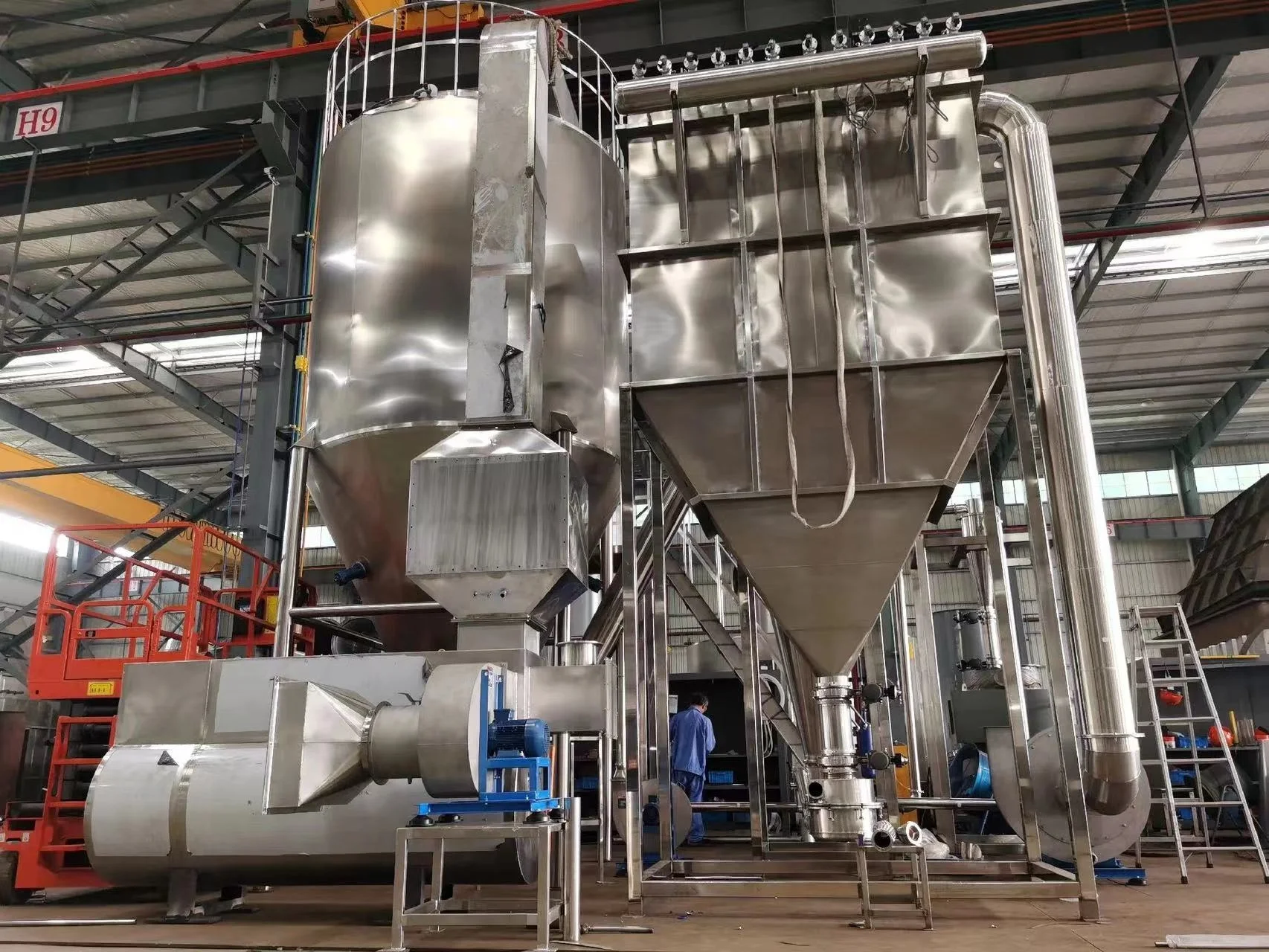
它是如何运作的
喷嘴雾化器使用高压或压缩空气. 这将液体进料破碎成小液滴. 液体通过一个小孔. 力将液体变成喷雾. 喷雾在干燥室中形成雾状液滴. 雾化器的工作方式控制液滴大小. 液滴尺寸对于形成均匀颗粒和良好干燥非常重要. 工程师使用压力喷嘴或二流体喷嘴. 他们根据饲料的情况进行选择. 研究表明 更多的气流或压力会产生更小的液滴. 较小的液滴有助于控制液滴的形成方式. 这也让烘干工作变得更好. 旋流喷嘴和多喷嘴头示意图 显示内部零件如何改变液滴扩散和雾化. 测试证明喷嘴雾化器可以产生几乎大小相同的液滴. 这有助于使最终粉末的粒径均匀.
优点和缺点
喷嘴雾化器在喷雾干燥中有很多优点:
它们比旋转雾化器消耗更少的能量, 尤其是在大型系统中.
它们可以很好地控制液滴尺寸,从而使颗粒尺寸均匀.
由于活动部件较少,因此需要较少的固定.
他们为大型喷雾干燥机工作省钱.
它们适用于多种类型的饲料, 所以他们帮助了很多行业.
在 2023, 喷嘴雾化器组成 超过 38% 喷雾干燥机市场. 它们很受欢迎,因为它们效果很好,可以保持食品和药品的良好状态.
但喷嘴雾化器也有一些不好的地方:
They do not work as well with thick feeds. Thick feeds need more gas pressure to work right.
Needing higher pressure can make them hard to use with some materials.
They have a smaller spray angle than rotary atomizers. This can change how well they cover the drying chamber.
If the feed is thick, the flow inside can get unstable. This makes droplet sizes less even and drying less uniform.
Studies show nozzle atomizers can 最多保存 29% 活力 compared to some other nozzles. But you must set the atomizer just right to keep it working well and making even droplets. How well the atomizer works depends on pressure, feed type, and nozzle design. If used the right way, a nozzle atomizer gives good efficiency, even droplet size, and high-quality powder.
旋转雾化器
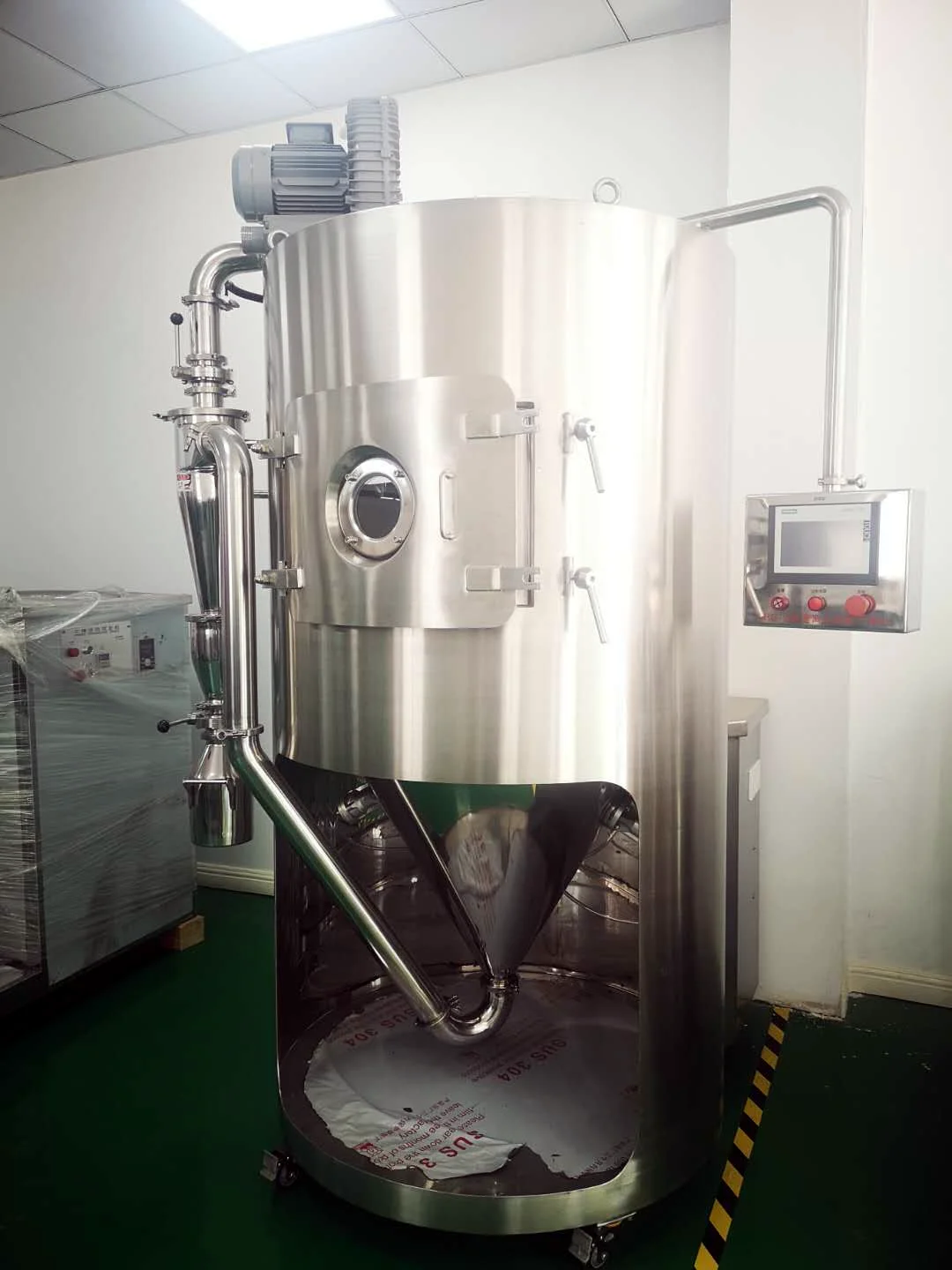
它是如何运作的
A rotary atomizer uses a spinning disc or wheel. The disc spins very fast. Liquid goes into the middle of the disc. The spinning pushes the liquid out to the edge. The liquid spreads into a thin layer as it moves. When it reaches the edge, the disc throws the liquid off. This makes a spray of small droplets. Hot gas in the drying chamber hits these droplets. The heat makes the droplets dry quickly and turn into powder. You can change the disc speed to make bigger or smaller droplets. This helps control the spray and works for many types of feed. It can handle thick or chunky materials too.
How well it works depends on a few things. 这 amount of liquid, the heat of the gas, and the shape of the atomizer all matter. These things change how big the droplets are and how fast they dry. Rotary atomizers can work with different gas flows. They can use gas that moves in the same or opposite direction as the droplets. This makes them good for things that cannot get too hot. The spray makes droplets of many sizes. This can change how good the powder is.
优点和缺点
Rotary atomizers have some good points in 喷雾干燥:
They can work with many kinds of feed, even thick or chunky ones.
You can change the droplet size by changing how fast the disc spins. This lets you control the spray very well.
They are good for things that cannot handle high pressure or too much heat.
Industry reports say rotary atomizers can be used in small or big jobs. They can handle from half a liter to over 10,000 liters each hour. Big companies like GEA Group and SPX Flow make these machines better. They work on saving energy and making the machines last longer.
But rotary atomizers also have some bad points:
They need more fixing because they have more moving parts.
They cost more to buy than nozzle atomizers.
The spray makes droplets of many sizes, so the powder may not be even.
方面 | 细节 |
|---|---|
Production Scalability | Can handle from 0.5 to over 10,000 liters per hour |
Industry Applications | Used in food, 药品, and chemical factories; good for dairy, plant proteins, fatty or thick products, and medicine |
Technological Innovations | Can change speed, use smart sensors, and warn when fixing is needed |
Equipment Longevity Factors | Saves energy, uses robots, keeps heat, and cleans easily |
Leading Manufacturers | GEA 集团, SPX Flow |
Market Trends | More money spent on saving energy, using robots, and making bigger machines; more use in new countries |
笔记: Rotary atomizers are flexible and can be used for many jobs, but they cost more and need more care.
Comparison
液滴尺寸
Choosing the right spray dryer atomizer helps control 液滴尺寸. Nozzle atomizers push liquid through a small hole using high pressure. This makes droplets that are almost the same size. You can change the pressure or nozzle shape to get the droplet size you want. This helps make powder particles that are even. Rotary atomizers use a spinning disc to throw out the liquid. The speed of the disc changes the droplet size. Faster spinning makes smaller droplets. Rotary atomizers make droplets in many sizes, not just one. This means the powder can have different particle sizes. Having even droplets is important for drying and powder quality. It helps the product dry the same way and gives better powder.
Nozzle atomizers make even droplets, so powder shape and drying are easier to control. Rotary atomizers let you change things more, but the droplets are less even.
能源使用
Saving energy is important when using spray dryers. Nozzle atomizers use less energy because they use pressure, not fast motors. This makes them good for big spray drying jobs. Rotary atomizers need strong motors to spin the disc fast. This uses more energy. Sometimes, rotary atomizers dry things faster because they make smaller droplets. This can help save some energy. New spray dryers use smart controls to set the best atomizer settings. This helps save energy too. Cleaning and checking the machines often also keeps 能源使用 低的.
喷嘴原子剂: Use less energy and work well with thin feeds.
旋转雾化器: Use more energy, but can dry better with good droplet making.
维护
How much care each atomizer needs is different. Nozzle atomizers are simple and have fewer moving parts. You need to check for blockages and worn holes to keep them working well. Cleaning and looking at them every day stops problems and saves time. Rotary atomizers have more parts, like the spinning disc and bearings. These need to be checked for dirt, shaking, and damage. Rotary atomizers need daily checks and more careful weekly checks, especially in big spray dryers.
喷嘴原子剂: Easy to take care of, less time stopped, but can get clogged.
旋转雾化器: Need more checks and cleaning, but smart tools can help stop long breaks.
容量
How much each atomizer can handle matters a lot. Rotary atomizers are best for big jobs. They can handle lots of liquid and work up to 40 tons each hour. They are good for thick or chunky feeds, so they fit big factories. 喷嘴原子剂, especially two-fluid ones, can’t handle as much. They work best with thin or not-too-thick feeds and when you need even droplets.
雾化器类型 | Typical Capacity Range | Feed Suitability |
|---|---|---|
喷嘴雾化器 | Low to moderate (limited for two-fluid) | Thin to moderately viscous |
旋转雾化器 | 高的 (up to 40 t/h) | Thin, viscous, or particulate |
Rotary atomizers are strong for big spray dryer jobs. Nozzle atomizers are better for small jobs that need even powder.
成本
Cost means both buying and running the atomizer. Nozzle atomizers cost less to buy and use, especially for small spray dryers. They also cost less to fix because they are simple. Rotary atomizers cost more to buy and fix because they have more parts. But they are worth it for big jobs or hard feeds.
喷嘴原子剂: Cheaper to buy and fix, good for saving money.
旋转雾化器: Cost more, but needed for big or special spray dryer jobs.
Powder Quality
Powder quality depends on droplet size, 烘干, and atomizer type. Nozzle atomizers make powder with even particle sizes. This helps the powder flow well and keeps the right moisture. It is important for food and medicine companies. Rotary atomizers can work with many feeds and make powder with different particle sizes. This is good for some jobs, but the powder may not be as even. Both atomizers change how the powder looks and works, which matters for spray dryer products.
Quality Metric | 喷嘴雾化器 | 旋转雾化器 |
|---|---|---|
Uniform, controlled by pressure | 多变的, controlled by disc speed | |
流动性 | 高的 | Moderate to high |
堆积密度 | Consistent | Can vary |
水分含量 | Well controlled | 好的, but may vary with droplet range |
适应性 | Best for strict quality requirements | Best for flexible, high-capacity needs |
Pick the atomizer that matches the powder quality you want and the spray dryer job you have.
Applications in Spray Drying
Small-Scale Production
Small-scale 喷雾干燥 is done in labs or small plants. These places use spray dryers that handle less than 100 kg each hour. People pick nozzle atomizer applications to control droplet size and dry gently. This keeps important parts safe in medicine and special foods. Ultrasonic nozzles are also used in small spray drying. They make droplets like those in big spray dryer systems. This helps when moving to bigger machines and keeps product quality the same. Important things like atomization pressure, inlet temperature, and slurry flow rate affect how well drying works. Moving the nozzle in a circle spreads droplets better and helps dry evenly. Computer models help improve these things, so fewer expensive tests are needed.
Nozzle atomizer applications: Great for research, new products, and when quality must be high.
Rotary atomizer applications: Not used much because cleaning is hard and fixing takes time.
Large-Scale Production
Big factories use rotary atomizers for making lots of powder. Rotary atomizer applications are best in big spray dryer systems. They can handle 200 liters or more each hour. Rotary atomizers work with many feed rates and thick liquids. This makes them good for food, 牛奶, and chemical spray drying. Rotary atomizers keep working well even with lots of solids. Nozzle atomizers are also used in big jobs, mostly when many nozzles work together. But each nozzle can only handle a little at a time, so rotary atomizers are better for big, nonstop jobs.
雾化器类型 | Key Advantages | |
|---|---|---|
Nozzle | Small to moderate | Precise control, easy cleaning |
Rotary | Large-scale production | High throughput, flexibility |
Viscous or Particulate Feeds
Spray drying often uses thick or chunky feeds. Rotary atomizers are good for these by changing disc speed and feed rate. This lets rotary atomizers keep drying well and working fast. 喷嘴原子剂, especially two-fluid ones, can also dry thick feeds. They do this by changing gas flow and pressure. Operators can change droplet size and powder shape by adjusting these things. Both types need the right mix of feed thickness, 流动, and atomization to get the powder they want.
提示: Changing atomization settings helps control droplet size and makes drying better for tough feeds.
Heat-Sensitive Products
Heat-sensitive products need gentle spray drying to stay good. Nozzle atomizers give exact droplet size control, which keeps the product safe. Operators can change pressure and flow to control particle size and drying speed. Special nozzle designs, like ink-jet heads, make even droplets and better powder. Co-current spray drying, where hot air and droplets move together, helps protect heat-sensitive stuff. Rotary atomizers can also dry heat-sensitive feeds, but nozzle atomizers give more control for these jobs.
喷嘴原子剂: Best for medicine, 奶制品, and bioactive products.
旋转雾化器: Used when you need to make a lot and need flexibility.
Spray drying keeps getting better, with new trends for saving energy and making atomizers work well. Operators pick atomizers based on how much they need to make, what the feed is like, and what the product needs to be. This helps them work better and make good powder.
Picking the right atomizer for a spray dryer is important. It changes how well the machine works and how much energy it uses. Studies show nozzle atomizers are best when you need small, even droplets. They also work well for small or medium jobs. Rotary atomizers are better for big jobs. They can handle thick or chunky feeds and make more powder. Real-life examples show that using the right atomizer helps save energy and makes better powder.
喷嘴雾化器 | 旋转雾化器 | |
|---|---|---|
Performance | 高效率, 精确控制 | High capacity, flexible performance |
效率 | Energy-saving, low maintenance | Handles viscous feeds, robust design |
Spray Drying Suitability | Small to medium scale, uniform powder | Large scale, varied feed properties |
To get the best results, pick an atomizer that fits your spray dryer size, the type of feed, and what you want to achieve. This helps you save energy and get good powder every time.
常问问题
What is the main difference between a nozzle atomizer and a rotary atomizer?
A nozzle atomizer uses pressure to make even droplets. A rotary atomizer has a spinning disc that makes droplets in many sizes. Each one works best for different kinds of feeds and job sizes.
Which atomizer is easier to maintain?
Nozzle atomizers have fewer parts that move. They are easier to take care of. Rotary atomizers have spinning parts, so they need more checks.
Can rotary atomizers handle thick or chunky feeds?
是的, rotary atomizers can work with thick or chunky feeds. Their design lets them handle tough materials. Nozzle atomizers can get clogged by these feeds.
Which atomizer produces more uniform powder?
喷嘴雾化器使粉末更均匀. They control droplet size better. Rotary atomizers make powder with many different sizes.
How does atomizer choice affect energy use in spray drying?
Nozzle atomizers usually use less energy. Rotary atomizers need more power to spin the disc. How much energy you use depends on the feed and job size.
提示: Pick the atomizer that fits your product and process to get the best results.



